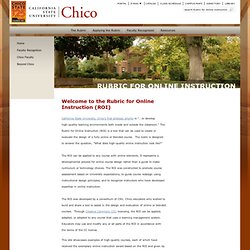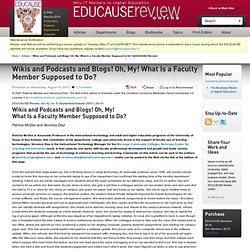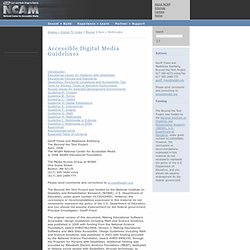

Introduction%20to%20the%20Quality%20Matters%20Program%20HyperlinkedFinal2014. Education for a Digital World. Co-published by BCcampus and Commonwealth of Learning, 2008 NOTE: This first edition of the book is only available in electronic form - please see links to the right.A second edition has been published.

Please see: information on the 2nd Edition of this book, Education for a Digital World 2.0 (2011). Print copies are available for order from Open School BC. The 2nd edition is not published by either COL or BCcampus. Quality Matters Program. Principles of Online Design. LEC_Online_course+rubric. Illinois Online Network: Initiatives. Guidelines_model_2013. Welcome to the Rubric for Online Instruction (ROI) - Rubric for Online Instruction. California State University, Chico's first strategic priority is "...to develop high-quality learning environments both inside and outside the classroom.

" The Rubric for Online Instruction (ROI) is a tool that can be used to create or evaluate the design of a fully online or blended course. The rubric is designed to answer the question, "What does high-quality online instruction look like? " The ROI can be applied to any course with online elements. It represents a developmental process for online course design rather than a guide to make curriculum or technology choices. The ROI was constructed to promote course assessment based on University expectations, to guide course redesign using instructional design principles, and to recognize instructors who have developed expertise in online instruction. The ROI was developed by a consortium of CSU, Chico educators who wished to build and share a tool to assist in the design and evaluation of online or blended courses. OCEP%20Evaluation%20Categories. Higher Ed Program > Rubric. The Quality Matters Higher Education Rubric, Fifth Edition, 2014 is a set of 8 General Standards and 43 Specific Review Standards used to evaluate the design of online and blended courses.

The Rubric is complete with Annotations that explain the application of the Standards and the relationship among them. A scoring system and set of online tools facilitate the review by a team of Peer Reviewers. Unique to the Rubric is the concept of alignment. This occurs when critical course components - Learning Objectives (2), Assessment and Measurement (3), Instructional Materials (4), Course Activities and Learner Interaction (5), and Course Technology (6) - work together to ensure students achieve desired learning outcomes.
Specific Standards included in Alignment are indicated in the Rubric Annotations. Download the Standards from the QM Higher Education Rubric**. ** Please note: This document requires you to Sign In using your MyQM account credentials. Blackboard Catalyst Awards. Thompson_onlinecoursequality. GuidetoCourseDesignAug05. Wikis and Podcasts and Blogs! Oh, My! What Is a Faculty Member Supposed to Do? © 2007 Patricia McGee and Veronica Diaz.

The text of this article is licensed under the Creative Commons Attribution-NonCommercial 3.0 License ( EDUCAUSE Review, vol. 42, no. 5 (September/October 2007): 28–41 Patricia McGee and Veronica Diaz Patricia McGee is Associate Professor in the instructional technology and adult and higher education programs at the University of Texas at San Antonio. She contributes at the department, college, and university levels in the support of faculty use of learning technologies. From the moment Kim Vega wakes up, she is thinking about or using technology. The Never-Ending Gaps The gaps between students' and faculty members' use of technology have widened. It is not surprising that today's learner brings more advanced skills and higher expectations to the college/university learning environment. The portrait of faculty members' experience with technology over the same time period is quite different.
GuidetoCourseDesignAug05. Open Source Digital Content. Invent + Build / Web + Multimedia / Accessible Digital Media Guidelines. Introduction Educational Issues for Students with DisabilitiesEducational Policies and StandardsDisabilities, Functional Limitations and Accessibility TipsTools for Access: Types of Assistive TechnologiesAccess Issues for Selected Development EnvironmentsGuideline A: ImagesGuideline B: FormsGuideline C: TablesGuideline D: Digital PublicationsGuideline E: Interactivity Guideline F: GraphsGuideline G: MathGuideline H: Multimedia Guideline I: Multimedia in E-booksGuideline J: Multimedia in DTBs AppendicesAcknowledgementsExpanded Table of Contents Geoff Freed and Madeleine Rothberg The Beyond the Text Project April, 2006 The WGBH National Center for Accessible Media © 2006 WGBH Educational Foundation The Media Access Group at WGBH One Guest Street Boston, MA 02135 (617) 300-3400 voice (617) 300-2489 TTY Please send comments and corrections to access@wgbh.org The Beyond the Text Project was funded by the National Institute on Disability and Rehabilitation Research (NIDRR), U.S.

Survey of Technology Tools for Student Engagement. HETL.pdf. Best Practices in Online Teaching. Effective-Assessment-Examples. Examples-of-Multiple-Choice-Items-at-the-Levels-of-Bloom. Education for a Digital World. 2011-final. Teaching Online : Effective Online Assessment: Scalable Success Strategies. Effective Online Assessment: Scalable Success Strategies Seminar Date: January 27, 2011 at 2:00pm Abstract: In the face of larger numbers of students in online courses and the challenge of designing effective assessments in an online environment, the need is greater than ever to implement scalable strategies that mitigate academic integrity issues.

In this recorded session, presenters will review a variety of assessment techniques applicable to many disciplines. Presenters Bobby H. Dr. Denise Lowe, Ed.D. Dr. Session Recordings and Supporting Materials Recordings Full Adobe Connect recording [32 minutes; swf file] (includes interactions between online participants as well as slides and synchronized audio; due to some audio issues, please maximize volume in Connect and then adjust computer’s volume as necessary) Session Audio: Play Online [32 minutes; flv file] Session Audio: Download [31 minutes; mp3 file] Presentation Slides [302kb; pdf file] Supporting Materials.
Cheating in the Digital Age: Do students cheat more in online courses?y. Finalreport.pdf. Hy-Sup. Online courses are second choice for community college students in some subject areas @insidehighered. The wholesale replacement of community college curriculums with online courses might not be the best idea, according to new research from the Community College Research Center at Columbia University’s Teachers College.

That’s because community college students prefer face-to-face courses over their online equivalents in certain subjects, the study found, particularly courses they consider difficult, interesting or important. The researchers conducted one-on-one interviews with students and found the majority “felt they did not learn the course material as well when they took it online," according to the study. “For most students, this deficit was due to reduced teacher explanation and interaction.”
The study, which is part of a larger research project, was based on interviews with 46 students who were attending two Virginia community colleges who had taken both kinds of courses. But Poulin said community colleges need to be strategic about where to add online options. Mixed Application. Blended learning revolution: Tech meets tradition in the classroom. Fourteen-year-old Gabi Directo is technically in the middle of her freshman year.

But in bursts of learning, hunched over her laptop in her Summit Shasta High School classroom, she has managed to zoom at her own rapid pace to the completion of all of her ninth-grade English, history, science, and math classes. By February, she was digging into her sophomore year Advanced Placement biology, physics, and Algebra II classes. Skip to next paragraph Subscribe Today to the Monitor Click Here for your FREE 30 DAYS ofThe Christian Science MonitorWeekly Digital Edition But in her school's "blended learning" program, Gabi has had as much face-time with teachers and classmates as solitary face-to-screen time.
Gabi says she thrives on the traditional classroom group work everyone does at the same time – but she also appreciates that she can use her more advanced skills gained in the independent work she does online, shooting ahead rather than waiting for her classmates to catch up. Technology in Vocational Educaton and Training (VET) From Optional to Required: Orientation, ACA 122, and Early Alert at Durham Tech. Details: Durham Technical Community College's faculty, staff, and students identified a need to enhance the college's front door experience as a result of our work with the national Achieving the Dream initiative and from data collected from the Survey of Entering Student Engagement (SENSE).
